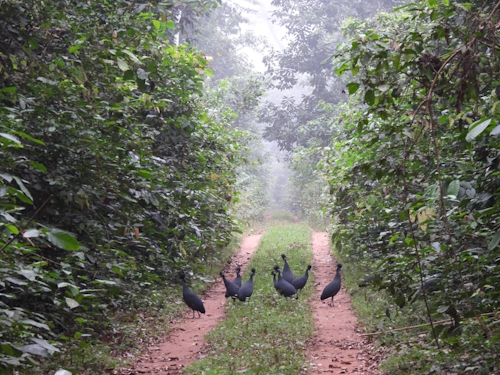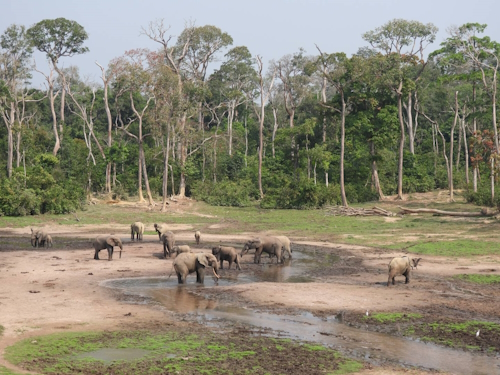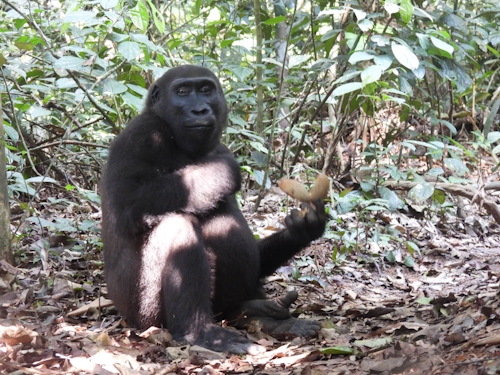Blog WHS Visits
WHS #886: Sangha!
These natural clearings filled with wildlife from the Congo Basin are the holy grail among mammal watchers. For me, Dzanga Ndoki (the Central African Republic part of this transnational site) was to be a splurge visit in March 2020 – but it became my Covid travel disaster. After the park reopened, I still wanted to go but the prices rose beyond belief. Fortunately, I found a group tour operator wanting to do it for much less by entering overland from Cameroon.
This site also had been unreviewed so far on this website. Sangha Trinational WHS consists of 3 parks, of which the one in the Central African Republic (C.A.R.) surprisingly is the best equipped to receive visitors. Lobéké in Cameroon is rundown, while Nouabalé-Ndoki in Congo is temporarily closed and rumours have it that they want to turn it into a luxury destination. I wrote a Getting There topic on the Forum to elaborate on the practicalities of visiting the park in the C.A.R. This review further deals with what you can expect there.

Our first day was spent at Dzanga Bai, the most famous forest clearing, known as ‘the Serengeti of the Forest’. It’s already a fine place to get to, starting with a drive through the forest of about 45 minutes and then an easy hike of the same duration. The latter includes a foot crossing of some flooded areas, where the water reaches just below the knee. Especially on the way back the cool water provided a welcome respite from the heat.
After walking through the forest for a while, you suddenly begin to see the sky again: that’s where the Dzanga Bai starts. A comfortable viewing platform (shaded, with chairs, and we brought drinks and lunch) provides the classic overview of this forest clearing. The Bai is the size of several football fields. There were already some 80 forest elephants present when we arrived and also a small group of forest buffalo. Other forest animals come here too, but they are shy and seem to get bullied by the elephants. They also chased the buffaloes away after a while.
What follows is hours of silent observation of the coming and going of the elephants. They take mud baths, socialize and some rowdy young guys have a few trunk fights. In this season (January) there were also many babies and large bulls present. We lasted 4 hours and it was almost a meditative experience.

During the second day in the park, we drove even further inside on a dirt road surrounded by very high trees. It ends at Bai Hokou, another ‘bai’ that is visited by forest animals but not in the same numbers as Dzanga Bai. Here lies the ranger and research station for the park’s western lowland gorillas. Until last year they had 3 habituated gorilla groups here, but within a month two of the silverbacks died (of natural causes). So we went to visit the remaining family of Makumba, a 40-year-old male with two wives and four kids. Before the visit, we had to do a rapid Covid test at the park office to prevent we would transmit the disease to the animals.
After having done mountain gorilla treks in Bwindi and Virunga before, I was curious to see how the lowland gorillas would differ. The flat terrain surely makes the hike easier, but it’s a humid area and you only walk on animal trails so there are a lot of roots and branches along the way. I was in the second ‘batch’ of visitors of my tour group (any group larger than four would have a hard time getting a view), so the trackers already found the gorillas and we reached them after two hours of hiking. They continued to walk away from us at first and were constantly turning their backs to us - we had to follow them crawling through the bushes. Based on this experience I’d say the mountain gorillas are harder to reach but easier to see once you have arrived. The allowed one hour at the gorillas of Bai Hokou was hard work, but finally, two of them settled down to eat and we could get good pictures from about 3m away. Their looks are slightly different from the mountain gorilla, with a streak of red-brownish hair on their forehead and altogether a different facial build. As they live in smaller family groups, you also see fewer individuals during your visit.

Sangha truly stands out because of:
- How ‘wild’ it is - it's almost untouched by human interference, where national parks in Southern Africa and Eastern Africa often are 'engineered' nowadays, with species being reintroduced, their numbers regulated, fences built, waterholes dug out, hardly a lion to be seen without a collar. Especially Dzanga Bai is just what it has always been, with only a viewing platform for scientists and tourists to observe. We also saw a wild, unhabituated gorilla cross the road on the way to Bai Hokou.
- The opportunity to see the forest mammal species of the Congo Basin. They all (elephants, buffaloes, gorillas) are a bit smaller in size than similar species elsewhere. They are well adapted to living in the dense forest and the narrow spaces that come with it. Even the humans are smaller here! The areas around the park are inhabited by the Ba’ka people, and they also are employed as gorilla trackers. Just following them through the bush you come to admire their agility and with their small stature they avoid getting all the branches in their faces as clumsier and taller tourists get.
It sure was worth the 4-year wait and the 3 full days of travel to get to Dzanga Ndoki. The visit made my appetite for other WHS in the Congo Basin like Odzala and Ivindo grow even stronger.
Els - 21 January 2024
Comments
Carlo Sarion 21 January 2024
Thanks Els for giving us an account of the Sangha Trinational WHS, and a glimpse of this part of the Congo Basin. Surely this will motivate others to explore the area, although I do hope that it remains almost untouched by human interference.
Kyle Magnuson 21 January 2024
This really looks like a special experience. Congrats on making it happen!